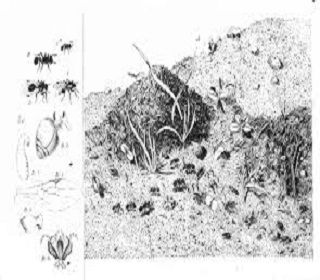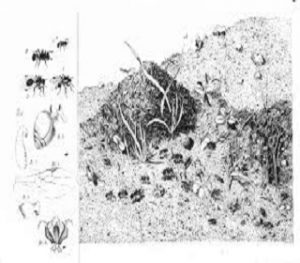



Animals of different species have contributed to show us the way in taking benefit of the chances which nature affords us both to protect and to feed ourselves, but the trapdoor spider is surely one of the most cunning animals on earth. Trapdoor spiders have a lot of enemies, ranging from insects to men, and many of them retain huge advantages over them in both strength and dexterity. So birds are the bitterest enemies of trapdoor spiders because they are rapid in movement and able to hide where spiders cannot follow them; other enemies are provided with a suit of armor, against which trapdoor spiders haven’t any chance, while their bodies are exposed to dangers from them.
These problems are countered by trapdoor spiders with a number of cunning devices, and if cunning ideas are to be regarded as possible evidence of intelligence, it is very important to remember that trapdoor spiders are, all in all, our relatives, and virtually members of the human family. The so-called trapdoor spider which lives in warm countries is undoubtedly one of the most resourceful spiders in the world. The trapdoor spider belongs to a numerous group of spiders not only largely widespread in America (especially in California, Nevada and Arizona) but also in the Mediterranean countries, Africa and Australia.
This species of spiders both builds its home by burrowing a hole in the ground and covers it with silk to prevent falls. Besides, the trapdoor spiders build a door to keep out the rain and other unpleasant surprises. The trapdoor spider both uses a safety-lock providing its door by a flexible and durable silk hinge, and usually it leaps on the prey at the entrance of its door. When trapdoor spiders identify the prey passing by, they attack it and soon return to the bottom of their home. The trapdoor spider hides the entrance to its home by placing moss on the outside of the door so that the entrance to its house camouflages itself with the surroundings. The detection of the trapdoor spider’s house is particularly hard because it is also protected with a layer of white lichens that divert visual attention from the nest.
Only the female trapdoor spider takes part in building the nest, while the male trapdoor spider has nothing to do with this work, wandering round the countryside in search of females, and digging holes in the ground. Instead, the female trapdoor spider takes charge of the children, treasuring both them and her home, and getting them away from all dangerous circumstances. Sometimes, the female trapdoor spider digs another room, joining it throughout a tunnel to her main residence, and using it as a second emergency room. When the situation becomes particularly dangerous, the female trapdoor spider and her family take refuge in the second room, blocking the door.
Trapdoor spiders can live for many years, usually spending all their life in the ground, from which they come out hardly. As for female trapdoor spider, she never leaves her home. When the breeding season occurs, the female trapdoor spider closes hermetically the door. Trapdoor spiders hunt at night camouflaging with the ground; once captured the prey they run as fast as they can to their nests. Ecological studies carried out in the world show that trapdoor spiders are active in all seasons and in different localities. Soil moisture and wet conditions would seem to be the only important factors influencing their lives.
Trapdoor spiders are predators, eating insects like birds or small mice, and even other spiders. They play also an important role in controlling the number of insects because they are voracious insectivores, and we must admit that trapdoor spiders not only don’t spread disease but also they are helpful for humans, devouring thousands upon thousands of pest insects, and so playing a key role in the environment. In their turn, trapdoor spiders are an important food source for many species of birds because of trapdoor spider silk is crucial for some species of birds that depend on it for nest construction.
Another wonderful characteristic of trapdoor spiders seems to be their reliance to fire. Studies carried out in Australia show that sometimes several species of trapdoor spiders select soils resilient to fire for their nests, adapting them to the inevitable environmental risks. And so, when the fires rage, the trapdoor spider’s nests put up fierce resistance to them. Relevant research has been carried out in Australia by few scholars in 1991-1992, with the purpose of studying how “selected species” of trapdoor spiders may survive even in the case of large, hot fires.
Studies on trapdoor spiders are usually a difficult task because of the remarkable lack of interest among the people and erroneous ideas. So many people believe that trapdoor spiders are harmful to humans, but in reality they restrict themselves to eat other insects. Seeking to obviate misconception, many established cultural organizations both in the United States and abroad have developed several approaches that focus on trapdoor spider’s behavior. The first difficulty arises from the fact that trapdoor spiders have hidden behaviors, and so specialists have problems detecting those that are present in many countries in the world.
Besides, according to the studies published in the PLoS ONE Journal, it seems that even if trapdoor spiders are sedentary, one variety of them voyaged across the Indian Ocean from South-Africa to Australia. They landed in South Australia’s Kangaroo Island throughout ships and other method of transport like floating trunks of trees, “rifting” or “oceanic currents.” One might say that trapdoor spiders are not travellers, but they seem to have made an impressive journey from Africa across the Indian Ocean to Australia. Now they hardly move away from their nests and so are controllable and have been deeply studied.
Generally, we can conclude that the so-called “mygalomorphs,” commonly known as trapdoor spiders, can cohabit with humans, because today their habitat is restricted to remnant vegetation and isolated areas. On the other hand, as we have seen, trapdoor spiders live in burrows and their nest is hermetically closed by them. Trapdoor spiders are sedentary, and they aren’t harmless to people. Many studies on trapdoor spiders are carried out by scientists in a lot of countries in the world because, above all, their nests are considered veritable works of art, even if much remains to be found out.
Notes
Bibliography on trapdoor spiders is truly boundless. Every nation today, from the United States to Australia, produces a significant amount of research on the subject. In an effort to simplify bibliography, I have grouped only several works that are focused on suggestions that take on very curious and interesting aspects of trapdoor spiders:
As for fire resistance, see Barbara York Main & Kylie Gaul, Response of Trapdoor Spiders to Fire in the Stirling Range. Zoology Department, University of Western Australia (1991-1992), p. 4.
As for the adventurous journey of Trapdoor spiders, the topic is largely widespread on the Web, but the original source is the PLoS ONE Journal:
Sophie E. Harrison, Mark S. Harvey, Steve J. B. Cooper, Andrew D. Austin, Michael G. Rix (2017) Across the Indian Ocean: A remarkable example of trans-oceanic dispersal in an austral mygalomorph spider, in PLoS ONE 12(8): e0180139. https://doi.org/10.1371/journal.pone.0180139.
Link to the article: Journals.plos.org/plosone/article?id=10.1371/journal.pone.0180139.
For general information, you may see:
Richard J. Adams & Timothy D. Manolis, Field Guide to the Spiders of California and the Pacific Coast States, Berkeley & Los Angeles, University of California Press, 2014.
A work characterized by high specialization level:
Jason E. Bond, Phylogenetic Treatment and Taxonomic Revision of the Trapdoor Spider Genus ‘Aptostichus’ Simon (Araneae, Mygalomorphae, Euctenizidae), on ZooKeys. A Peer-Reviewed Open-Access Journal, Sofia-Moscow, Pensoft, 2012.
An article of some interest, contained in Popular Science Monthly, Feb. 1923, pp. 52-53, and entitled Professor Braves Death to Prove Dread Spiders Are Man’s Friends, was written by Prof. W.J. Baerg (University of Arkansas).
Nggak Nyangka! Hidup Gue Berubah Total! Gue bukan siapa-siapa. Cuma anak kos biasa yang kerja serabutan buat nutup biaya hidup… Read More
What is the Main Cause of a Heart Attack? What is its Solution? A heart attack is the blockage of… Read More
In the vast economic arena, one term that often takes center stage, inciting extensive debates and discussions, is the "debt… Read More
De-Dollarization: The Changing Face of Global Finance The financial landscape is in a state of flux, with an intriguing economic… Read More
The curtains closed on a dramatic Bundesliga season with Bayern Munich standing tall once again, clinching their 11th straight title.… Read More
The Unfolding Story of Celine Dion's Health In recent news that has left fans across the globe stunned, iconic singer… Read More